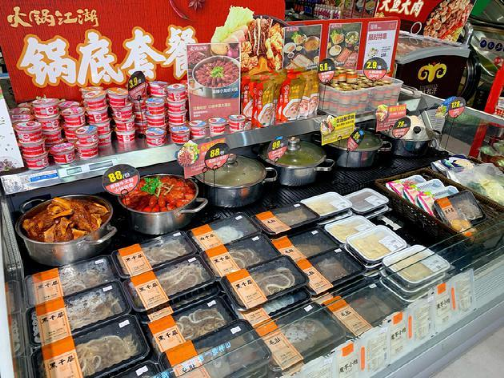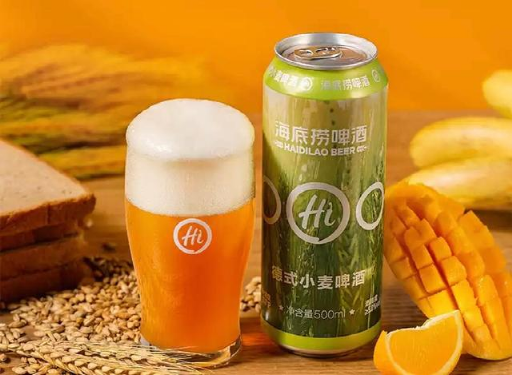It is completely possible to compare prices on the takeaway app, which is very disadvantageous for entrepreneurs who go on their own: upwards, with the price of hot pot stores as a constraint. Downward, community grocery shopping apps can play a role as a cheap substitute. Apps such as Dingdong grocery shopping have begun to make hot pot takeaways, providing one-stop food processing for washing, cutting, and mixing.
So far, Haidilao, Xiabu, Hema and community grocery shopping apps have directly demarcated the hot pot takeaway market. Even if entrepreneurs have avoided the hot pot giants, they will not be able to hide from the pervasive community grocery shopping apps, and there is no premium space at all. . A set of statistics from Zhihu user @外卖 players shows that in 2018 Shanghai Ele.me platform had 341 hot pot takeaway stores, but more than half of the stores closed and withdrew after six months.
On the other hand, hot pot takeaway in disguise sacrifices two very important sources of profit for hot pot: repurchase and drinks.
Why do you say that a hot pot meal is three catties fatter?
“Waiter, add two plates of fat lamb and a shrimp slip!”
The social attribute attached to hot pot comes with the addictiveness of “eating and eating”. While eating and chatting, you always have to rinse something in the pot. Plus plus, the customer unit price goes up. Haidilao, like Haidilao, knows this well, and even cancels the option of “package”, which increases the possibility of triggering repurchase to a certain extent.
The hot pot takeaway is completely incomparable. Just imagine, what happens if you ask for a hot pot takeaway and find that there is not enough food? The most likely solution is the supermarket downstairs. This is reflected in the difference in the customer unit price between Haidilao’s takeaway business and in-store business: the financial report shows that the per capita consumption of Haidilao’s takeaway business in the first half of 2020 was 112.8 yuan, and this data was only 104.4 yuan in the same period in 2019. As for the in-store business, open Dianping and search for “Haidilao” in any city, and you will find that the per capita consumption is mostly around 150 yuan.
The same is true for drinks. Generally, users who call hotpot takeaways will bring their own drinks, unless the hotpot restaurant overpriced the drinks, or the drinks offered are somewhat differentiated. For example, Haidilao’s craft beer, Xiabu Chamicha. Otherwise, this part of the sales profit will be diverted, and the “revenue degradation” is very obvious.
To sum up, the hot pot takeaway destroys the profit model of the traditional hot pot scene, turning a good business into a bitter business for working upstream.
For the “three-nos” entrepreneurial team with no capital battery life, no operating barriers, and no scale advantage, just look at the lively hot pot takeaway, don’t wander into the muddy waters.
Those who have the supply chain get hot pot takeaway
Since the hot pot takeaway is laborious and unpleasant, how can we explain the massive invasion of the giants? In fact, this behavior can be regarded as “curving to save the country.”
The giants use hot pot takeaway as the anchor of the “fresh food + convenience store” scenario to further export supply chain capabilities. Like the 40-square-foot “hot pot ingredients supermarket” SKU of over 100, Hema hot pot has thousands of ingredients to choose from. As we all know, fresh food and convenience stores are almost “whoever does it” business. There are only a handful of companies that can survive on their own profits and losses, such as Yonghui Supermarket and Bianlifeng, relying on self-built supply chains and refined operations to kill blood.
Similarly, every link in the Haidilao supply chain can be called a unicorn in the subdivisions. For example, Yihai International, which makes hot pot bottoms and condiments, Shuhai Group, which provides food processing and warehousing services, and mutton supplier Zalut Qi Haidilao, etc., even Haidilao’s takeaway pots can be customized to reduce costs. Hema Hot Pot is backed by Alibaba and has direct sourcing bases and supply chain capabilities for fresh produce at home and abroad.
The seemingly “light” hot pot takeaway has a complete supply chain behind it. Hot pot takeaway is not so much a new dining outlet, as it is a continuation of the war in the field of fresh food e-commerce. Who can maximize the advantages of the supply chain, who can have the last laugh in the economies of scale of hot pot food delivery.
From an optimistic perspective, hot pot takeaway provides a new pricing idea for fresh food retail. Under the traditional model, fresh food sales are “by the catty”, and profit margins are limited. However, the “platter-style” service provided by hot pot takeaway adds a premium possibility of providing solutions. One of the most intuitive examples is the fruit shop and fruit fishing, the latter can achieve much higher returns than the former through simple resource integration. Based on this, many community grocery shopping apps are also turning to use similar thinking to launch fast-handed recipes, one-person food and other classification labels.
Another trend is that there are many kinds of ingredients involved in hot pot. Now young people work at a fast pace and the kitchen frequency is low. When they go to the supermarket to purchase excess ingredients, they can only be destroyed in the refrigerator. Rather than waste, they would rather use this part of the budget in exchange for the peace of mind of “buy as much as you eat”. Hot pot takeaway solves the problem of diversity of ingredients and “appropriate quantity”, caters to the consumer psychology of users while improving the living space of enterprises, which can be regarded as a win-win business micro-innovation. What’s interesting is that traditional fresh food and retail channels have not taken any action against this young user’s pain point, but have allowed Haidilao, Hema, and community grocery shopping apps to find shortcuts.
The wool comes out of the pig
A few years ago, people could hardly imagine the rise of hot pot takeaway. Because in the eyes of many people, this is almost equivalent to collecting IQ taxes. The bottom material, dipping material, and main ingredients are all available in community supermarkets. The so-called hot pot takeaway is nothing more than integrating these necessary products for resource integration and running errands.
Hot pot is the lower limit of the “labor” of home cooking. Plug in the induction cooker and simply clean the ingredients to start eating. The steps are so simple, there is no need to pay extra for hot pot takeaway. But it is precisely the small pain points such as simple cleaning and tableware cleaning that have made the hot pot takeaway in the lazy economy era.
However, there is still a way to go between “discovering the pain points” and “making a business”, and this path is not easy. Because of this, many supermarkets and hot pot restaurants that have the ability to solve the pain points have no intention to provide hot pot takeaways for “lazy cancer” users. However, supply chain companies have three major advantages: low cost, “people do not have me”, and “people have me fine”. With the advantages of scale, marginal costs continue to decrease, and these companies can achieve the parity of hot pot delivery. profit.
Speaking of which, the ultimate answer for the giants to fight for hot pot takeaway should also be revealed, which is to gradually subvert the existing channels and the sales pattern of FMCG. In fact, Haidilao and Hema can create a new consumption decision chain from online to offline in the hot pot takeaway, which means that they can “carry private goods” on the new chain. Therefore, what should be most vigilant about the hot pot takeaway trend is the FMCG brand that originally relied on the advantages of offline channels to build a moat.
Every innovation based on user pain points will generate new market space. Let’s talk about two representative data: Hema’s Shanghai retail member store has private-brand products accounting for over 40%. Haidilao relied on 700 stores throughout the year and sold 432 million yuan worth of craft beer. This data is already considerable on the craft beer track.
So the logic of giants’ hotpot delivery is similar to the “popcorn economy” of movie theaters, using movie tickets as the basic plate to create excess revenue through self-operated products such as popcorn. Just like Haidilao, Xiabu’s seasonings and base ingredients that are now ubiquitous in traditional supermarkets, as the hot pot take-out model becomes available, “Hema Manufacturing” and “Haidilao Manufacturing” can continue to expand their brand influence , In more categories, and those fast-selling brands that rely on the old channel dividends to “lie to win”.
Where is this hot pot takeaway, there is clearly a “killing pig dish”.


